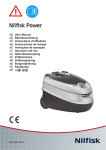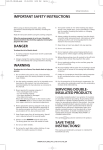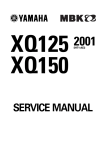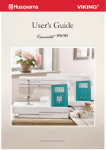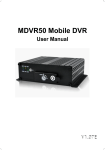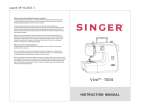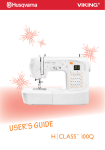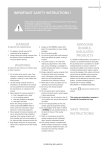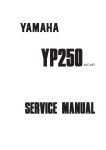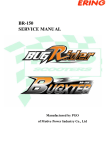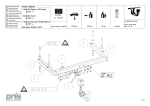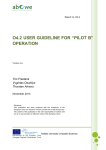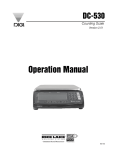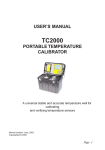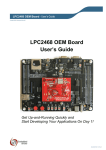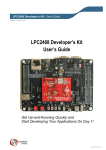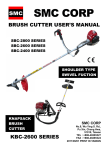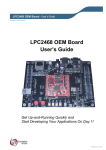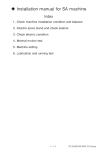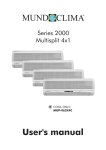Download Viking Designer 1 Service Manual
Transcript
SERVICE MANUAL Printed in Sweden Made in Sweden March 1999 104 72 47-26 Replaces 104 72 45-01 Contents Directions for use ESD Service tools Service program Upper thread tension - Functions of the service menu 3. Sensor check - Functions of the service menu 2. Calibration of the touch panel Update of the memory Covers 9 9 10 11 Upper rear cover Lower rear cover Front cover Parts of the front cover LCD Touch Panel Floppy disk drive 12 12 13 14 14 14 14 Settings 15 16 17 18 18 19 20 22 23 24 25 26 26 1. The play of the hook gear 2. Setting the hook in relation to the feeding eccentric (after feeding) 3. Belt tension, arm/lower shaft belt 4. Belt tension, motor belt 5. Setting the feeding unit sideways 6. Basic setting - the step motor of the needle 7. Setting of the needle in relation to the presser foot 8. The gap between the needle and the hook 9. The timing of the hook in relation to the needle 10. The needle height 11. Presser foot parallelism to the feed dog 12. Presser foot height to the stitch plate 13. Setting the stitch plate (the hook cover) in relation to the needle in the feeding direction. 14. The sideways setting of the stitch plate (the hook cover) in relation to the presserfoot. 15. The height of the hook 16. Pre-setting of the step motor for the side feeding 17. Setting the feeding mechanism sideways 18. Feed dog height 19. Threading device 20. Stitch length balance basic setting 21. Pre-setting the step motor of the feed dog 22. Stitch length balance 23. Lower thread tension (thread tension of the bobbin case) 24. Upper thread tension - Normal position 25. Upper thread tension - Embroidery position 26. Upper thread guard sensor 27. Setting the thread take-up spring 24. Upper thread tension 28. Disconnection when winding the lower thread 2 4 4 5 27 27 28 29 30 31 32 33 34 35 36 37 38 39 40 40 41 104 72 47-26 Dismantling and mounting Base Plate Transformer Circuit board - Circuit diagram Stop right circuit board Sewing head The step motor of the needle The step motor of the presserfoot lifter The thread tension compl. The hook cover compl, step motor house. Parts of the hook cover compl. Feeding unit Feed dog. The side feeding mechanism cpl. The step motor of the side feeding mechanism . The step motor of the feeding unit Hook compl. Bobbin winding device Cover Y-slide Step motor cover Embroidery Unit 42 43 44 45 46 47 48 49 50 51 52 53 54 54 55 56 57 58 58 Cover upper part Cover lower part Locker switch Embroidery unit - X-unit Belt tension Calibration of the end position, X-unit. Embroidery unit Y-unit Belt tension Calibration of the end position, Y -unit. Hoop holder The hoop sensor. Step motor, Y-unit Step motor, X-unit 59 59 59 60 60 60 61 61 61 62 62 63 63 Fault finding diagram. 64 104 72 47-26 3 Directions for use These service instructions are intended to be used by service workshop personnel, or by salesmen who carry out servicing their own districts. They assume a thorough knowledge of the handling of precision appliances and accessibility to service tools. The manual is divided into two sections and covers all service operations and checks which should be carried out when making a complete overhaul of a sewing machine. The first section deals with the various settings which must be maintained to ensure that the machine functions satisfactorily. The second section covers dismantling and mounting instructions. The diagrams only give indication as to where the detail or mechanism is located in the machine. For more detailed information regarding the construction, etc., refer to the diagrams in the spare parts list. ESD ATTENTION! It is of the utmost importance that precautions are being taken in order to avoid damage of the electronics by electro static discharges ESD (=Electro Static Discharge). To avoid that these errors arise it is important to handle loose circuit boards in a controlled way. Always use wrist band 412 23 02-01 when servicing. 4 104 72 47-26 Service tools A reasonable requirement in a domestic sewing machine is that it should able to sew all types of fabrics used in the home. The settings made when assembling and sewing-in the machines are those most suited to give the best results in the majority of fabrics and fabric combinations. In doing so, consideration has been given to the requirements of different markets. This does, however, mean that when sewing extreme fabrics, better results may be obtained in certain cases by altering the settings. It must be pointed out that these altered settings can cause poorer results on more normal fabrics. How the different standard ratings are set can be seen from the description under each setting instruction. The following list of setting gauges and service tools is intended as an instruction about the special service tools needed to servicing this machine. 1. On several different occasions the needle is used as a setting gauge. The setting ratings are adapted to needle 90. Make sure to use an undamaged needle. 2. Gauge for setting the timing of the hook in relation to the needle . Ref. No 411 17 52-01. 3. Gauge for the feed dog lift. Ref. No 411 49 93-01. 4. Gauge for the needle height . Ref. No 412 35 29-01. 5. Adam key 2.5 mm Ref. No 411 86 01-01 6. Adam Key 2 mm Ref. No 411 86 00-01 7. Adam key 1.5 mm Ref. No 411 66 89-01 8. Distance gauge 0.05-1,00 mm Ref: No. 412 38 85-01 9. Angel key Torx 6 Ref No 412 27 67-01 10. Screwdriver Torx 10 Ref. No 412 36 48-01. 11. Screwdriver Torx 20 Ref. No 412 36 49-01. 12. Screwdriver Torx 25 Ref. No 412 36 50-01 13. Cable set for service Ref. 412 49 08-01 14. Calibration of touch panel Ref. No 412 22 33-01 104 72 47-26 5 Service Program Service program In order to facilitate the checking and setting of the different functions of the machine there is a service program. Press Handling Get into the service program of the machine by pressing the reverse feed button and the sensor foot pivot button while the main switch (A) is switched on. The display will now show the Designer 1 service menu 1. See illustration below. 6 104 72 47-26 Service Program Service program Functions of the service menu 1. On the top of menu The revision of the program Service Menu 1 Row 1 Toucharea Needle/Feed Cal 0 Upper needle position - Checking the centre position of the needle step motor. Lower needle position - Checking the centre position of the feeding step motor. Needle Lpos Is used for pre-setting the step motor of the needle. The step motor of the needle now takes its left calibration position. Needle Opos Is used when setting the centre position of the needle. The step motor of the needle is now in its centre position. Needle Rpos Is used for pre-setting the stepmotor of the needle. The step motor of the needle now takes its right calibration position. Feed 0 pos Feed C pos Is used when coarse-adjusting the stitch length balance The feed dog should now stand still ( 0-feeding). Is used when pre-setting the feeding step motor. The step motor now takes its calibration position. Service Menu 1 Row 2 Side motion Side motion Tension Toucharea L R Menu LCD Contrast LCD Contrast Touch + Cal 104 72 47-26 Left position. Right position. Setting of the thread tension. (The machine will enter Service Menu 3) The contrast of screen. The contrast of screen. Calibration of the touch display. 7 Service Program Service Menu 1 Row 3 Servo-sewing head Toucharea On/Off Sewing heads Servo function ON and OFF. Servo - sewing head Embroidery Unit Cal Cal Embroidery Unit Cent Disp Sensors Menu Servo takes its calibration position. Is used to check the sideways and lenghtwise movement of the embroidery unit. The embroidery hoop sensor arm takes its centre position. Display test. A square pattern shall change between blue,red and green. After the check is done the machine will automatically enter the service menu 1 again. Sensor check. (The machine enters Service Menu 2). Service Menu 1 Row 4 Toucharea 0x0 Is used when coarse-adjusting the stitch length balance The feed dog should now stand still ( 0-feeding). 2,5x0 The machine sews straight stitch 2,5 mm. 4.0x0 The machine sews straight stitch 4 mm. 6,0x0 The machine sews straight stitch 6 mm. 4x4 The machine sews a zig zag stitch 4x4 mm. 6x6 The machine sews a zig zag stitch 6x6 mm. Service Menu 1 Row 5 Toucharea SM The machine sews a side motion stitch. Hem Mend Is used for fine-adjusting the stitch lenght balance. The machine now sews a pre-programed mending stitch. MM Rep The machine sews signs B,P,R,S. Embr The machine sews the first embroidery on an inserted Embroidery disk. Service Menu 1 Row 6 On-Time Sew-Time Embr-Time 8 Indicates how many hours and minutes the machine has been switched on. Indicates how many hours and minutes the machine has been sewed on. Indicates how many hours and minutes the machine has been embroidered on. 104 72 47-26 Service Program Sensor check - Functions of the service menu 2. Operation Get into the service program. Touch Sensor- , row 3. Active square is filled Check Check Check Check Check Check Check Check of armshaft's first sensor (stop right function) of armshaft's second sensor (stop right function) of needle of pressarfoot's first sensor of pressarfoot's second sensor of lower thread guard indicator of upper thread guard indicator if embroidery unit is connected Embroidery hoop sensor- Indicates when sensor is on calibration mark The bobbin winding sensor The bobbin winding sensor -Indicates when bobbin is wounded. Button hole sensor check Clr - Used to erase everything programed in the programmable memories ot the machine Back to service menu 1 Upper thread tension - Functions of the service menu 3. To facilitate the setting of the upper thread tension there is an electronic adjustment in the Service menu 3. Operation Get into the service program.Touch Tension- -,row 2. The machine will enter Service Menu 3. Tension Norm -Blue Is used for adjustment of the upper thread tension at normal sewing . The value is normally set between +10 and -10. The value on the display is changed gradually each time you touch the touch area. Note! There are limitations in the setting. The value of the setting could be higher then +10 or lower then -10 . Tension Embr- Red Is used for adjustment of the upper thread tension at embroidery sewing.The value is normally set between +10 and -10. The value on the display is changed gradually each time you touch the touch area Note! There are limitations in the setting. The value of the setting could be higher +10. Toucharea 2,5x0 The machime sews a straight stitch 2,5 mm 4x0 The machine sews a straight stitch 4 mm 6,0x0 The machine sews a straight stitch 6 mm 4x4 The machine sews a zig zag stitch 4x4 mm 0,4x6 The machine sews a zig zag stitch 0,4x6 mm Embr The machine sews the first embroidery on an inserted embroidery disk. Back Back to service menu 1 104 72 47-26 9 Service Program Calibration of the touch panel How to synchronize the touch area of the touch panel with the symbols on the screen. Get into the service program of the machine. Press the needle stop button or touch Touch ,row 2 in the service menu 1. 1. Touch with a blunt object in the center of cross 1 ,indicated First calibration mark on the illustration. When the colour changes from black to green the first calibration of the touch panel is set. 2. Touch with a blunt object in the center of cross 2, indicated Second calibration mark on the illustration. When the second and final calibration of the touch panel is set the machine will now automatically enter the service menu 1. First calibration mark 1 2 Second calibration mark Set the calibration of the touch panel with gauge 412 22 33-01 10 104 72 47-26 Service Program Update of the memory The Designer 1 has a memory in which the characteristics and stitches of the machine are stored. In order to update the memory the machine has an update mode. Revision of the program The revision of the program can be seen in the lower right side of welcome screen or checked in the service program menu 1 How to update 1. Insert the disk with the new memory information in the floppy disk drive. 2. Get into the update mode of the machine by pressing the start/stop button and the stitch re-start button while the main switch (A) is turned on. Press 3. The memory will now automatically be updated. 4. When the memory of the machine is correctly updated RESTART is indicated on the screen. Then... -Turn off the machine. -Remove the Floppy disk. 5. Re-start the machine and check the revision (see above). NOTE! If the Main PC board is changed the memory always has to be updated with the latest version. 104 72 47-26 11 Covers Upper rear cover 1. Remove the five screws (A). 2. Remove the two screws (B). 3. Remove the screw (C). Lower rear cover 1.Remove the screw (D). 2. Remove the lower rear cover pulling it backwards on the right-hand side and at the same time push the front covers upper and lower side of the free arm together. 3. Remove the socket of the embroidery unit by bending it away from the snap in the in the cover with a screwdriver on the corner behind the socket. 12 104 72 47-26 Covers Front cover Dismounting 1. Dismount the rear covers. 2. Remove the button for the bobbin winding sensor stop, by pulling it straight out. 3. Remove the two screws (B) from behind. 4. Remove the two screws (C) in the base plate. 5. Turn the hand wheel until the needle is in its lowest position, so the thread take up lever is out of the way. 6. Carefully bend away the front cover from the hand wheel and pull it straight out. NOTE! Pull carefully the front cover away in order not to damage the cables. 7. Remove the cable (D) of theLCD transformer box and the cable(E) of the LCD . 8. Remove the band cable (G) of the touchpanel board from the circuit board by pulling the outer covering of the white switch outwards. 9. Remowe the cable (F) of the floppy disk drive from the circuit board by pulling the outer covering of the black switch outwards. 10. Remove the two cables (H) and (I) of the push button assembly . 11. Remove the cable (K) of the thread tension. 12 Remove the cable (M) of the lamp. 13. Remove the earth cable from the LCD frame. Mounting Mount in reverse order 104 72 47-26 13 Covers Parts of the front cover LCD Dismounting 1. Dismont the rear covers 2. Dismount the front cover. 3. Remove the LCD frame from the front cover by dismouning the 4 screws (A). 4. Remove the LCD light cable (E) 5. Remove the LCD by dismounting the 4 screws (C). Mounting Mount in reverse order. Note! The black sealing should be on the the LCD. Touch Panel Can be removed after dismounting the LCD frame. Floppy disk drive Dismounting 1. Dismont the rear covers 2. Dismount the front cover. 3. Remove the LCD frame from the front cover by dismounting the 4 screws (A), 4. Remove the transformer box by dismounting the screw (B). 5. Remove the Floppy disk drive by dismount the 3 screws (D). 6. Remove the cable from the floppy disk drive. Mounting Mount in reverse order. NOTE! When mounting the cable the contact area of the cable should be facing the floopy disk drive 14 104 72 47-26 SETTINGS 104 72 47-26 15 Settings 1.The play of the hook gear It is impossible to obtain an equally large play in one rotation of the cog wheel, but it should be as small as possible at the tightest spot during the revolution. Check 1. Rotate the hook back and forth and check the play. 2. Do this check on at least 3 different spots during the revolution of the cog wheel. (Move the cog wheel with the hand wheel). Adjustment 1. Loosen, screw (A) in the bearing clamp 2. The play can now be adjusted by turning the eccentric bearing (C). NOTE! The hole (B) in the bearing shall always be on the lower half. 16 104 72 47-26 Settings 2. Setting the hook in relation to the feeding eccentric (after feeding) Check 1. The needle shall be in its centre position, straight stitching. 2. Set the needle in its lowest turning postion. 3. The tip of hook (A) shall now be centred behind the needle, and the tap of the worm gear should be positioned according to fig. 1. Note! The position of the pin shall be aligned with the frame opening. Adjustment 1. Loosen screw (B). Remove the hook and set it into its correct position. Note! The position of the pin shall be aligned with the frame opening. 104 72 47-26 17 Settings 3. Belt tension, arm/lower shaft belt 1. Dismount rear cover and front cover. 2. Dismount the bobbin winding device. 3. Loosen the two screws (A) of the bearing clamps. 4. The belt tension can now be adjusted by turning bearing (B) which is eccentric. NOTE! The hole (C) should always be on the front half. 4. Belt tension, motor belt 1. Dismount rear cover . 2. Loosen the 2 screws (A) and adjust the belt tension by displacing the motor. NOTE! The adjustment of the arm/lower shaft belt affects this adjustment. 18 104 72 47-26 Settings 5. Setting the feeding unit sideways Check 1. The distance A and B shall be equal between the screw (C) and the edge of feeding device shaft (D). Adjustment 1. Loosen the 2 screws in the feeding device. 2. Move the feeding device sideways until the distance A and B is equal between the screws (C) and the edge of feeding device shaft (D) 3. Tighten the screws. 104 72 47-26 19 Settings 6. Basic setting - the step motor of the needle Check 1. Insert a new needle 90 in the machine. 2. Set the needle in its upper turning position. 3.The needle should always get to the centre position, when the main switch is turned on repeatedly. Check Get into the service program of the machine. The needle should be in its upper turning position. Touch Needle - Needle point , row 1. The needle should now take its centre position in the presser foot. Touch Needle - , row 1. The needle shall now take its left position. The gap between the segment (A) and the calibration stop (B) should now be zero (0 mm). Note! The position of the eccentric. 20 104 72 47-26 Settings Adjustment Get into the service program of the machine. The needle should be in its highest position. Touch Needle - , row 1. Loosen screw (E) in the cog wheel (D) on the step motor shaft. Turn the cog wheel until the needle is in the centre of the presser foot. Touch Needle - , row 1 . Loosen screw (F) in the calibration stop (G) and turn it until the gap is correct (0mm). Note! The position of the eccentric. Touch Needle - , row 1 . Turn the screw (H) until the gap is correct (0 mm). This setting is only a sideways limitation. Touch Needle - , row 1 The needle should now take its centre position into the needle hole of the presser foot. 104 72 47-26 21 Settings 7. Setting of the needle in relation to the presser foot Check Insert a new needle 90 in the machine. When the machine is set at straight stitching centre position, the needle bar shall be set in such a way that a needle 90 passes through the centre of the needle hole in the presser foot. 1 = seen from the front 2 = seen from the side 1 2 Needle point Adjustment 1. Turn on the main switch Keep the machine set at straight stitching centre position (alt. service menu 1, touch Needle- , row1 ). 2. Loosen the two screws (A) and (B). Move the needle bar with the two eccentric screws (C) or (D) until the requirement is obtained. - The lenght movement is adjusted by moving the eccentric screw (C) - The side movement is adjusted by moving the eccentric screw (D) 3. Tighten the screws (A) and (B). 4. Check the setting by turning the main switch on and off a couple of times. NOTE! "The Setting of the needle in relation to the presser foot" affects the function of "6. Basic setting - the step motor of the needle". 22 104 72 47-26 Settings 8.The gap between the needle and the hook Check 1. Set the machine on straight stitching. 2. Insert a new needle 90 in the machine. 3. Rotate hand wheel until the tip of the hook arrives behind the needle. Check the gap by pressing a small screw driver against the needle. The gap should be as small as possible, but max 0.15 mm. Adjustment If the gap is too large: 1. Loosen the screw (A). 2. Turn screw (B) clockwise until the needle touches the tip of the hook 3. Turn screw (A) until the gap is correct If the gap is too small: 1. Loosen the screw (B) 2. Turn screw (A) to make the gap larger and then loosen the screw (A). 3. Turn screw (B) clockwise until the needle touches the tip of the hook 4. Turn screw (A) until the gap is correct NOTE! Always tighten screw (A). Check! 104 72 47-26 23 Settings 9.The timing of the hook in relation to the needle Check - Set a new needle 90 into the machine - Dismount the stitch plate, bobbin case holder and the bobbin case. - Set machine on straight stitching. - As the needle is moving upwards, the tip of the hook should pass behind the centre of the needle, when the needle is 2.5 mm above its lower turning position. NOTE! Before any adjustment is done check that the setting " 2. Setting the hook in relation to the feeding eccentric" is correct (see page 17). Check with setting gauge 411 17 52-01. 1. Turn the handwheel until the needle is at its lower turning position. 2. Place the setting gauge on the needle bar so that the springloaded stud (A) just touches the needle bar frame and tighten the screw. 3. Move the needle upwards with the handwheel until the springloaded stud (A) rests against its stop in the setting gauge. 4. The tip of the hook should now be behind the centre line of the needle. Adjustment 1. Remove the blank pointed screw (B) and loosen the other 2 screws in the belt wheel of the arm shaft. 2. Repeat checking points 1, 2 and 3 with setting gauge 411 17 52-01 . 3. Hold the arm shaft and turn the hook until its tip arrives behind the centre line of the needle. 4. Tighten one of the black screws. 5. Make sure the screw descends into the groove of the shaft so that the belt wheel is placed correctly sideways. 6. Check. 7. Tighten all the screws. 24 104 72 47-26 Settings 10.The needle height Check 1. Bring the needle into its lower turning position. 2. The gap between the upper end of the needle and the surface (B) of the hook ring should be 29.15 ± 0.2 mm. The check is executed with a polished needle 90 which is 29.15 mm long. Order nr. 412 35 29 - 01 Adjustment 1. Bring the needle to its lower turning position. 2. Loosen screw (A) and move the needle bar until the correct measure is obtained. 3. Tighten the screw. NOTE! Check by means of a twin needle that the needle bar is not twisted. May cause jump stitches when sewing with a twin needle. 104 72 47-26 25 Settings 11. Presser foot parallelism to the feed dog Check The presser foot (A) should be parallel to the feed dog (B) . Adjustment 1. Loosen screw (C) and turn the presser foot until it is parallel to the feed dog. 2. Tighten the screw (C). 12.Presser foot height to the stitch plate Check When the pressar foot is in its highest lifting position it shall be approx. 13 mm above the stitch plate. Adjustment 1. Get into the service program 2. Touch Servo - , row 3. The pressar bar now takes its highest lifting position. 3. Loosen screw (C) and move the presser bar until the pressar foot is approx. 13 mm above the stitch plate. 4. Tighten the screw (C). 13 mm Note! This setting affects: 11. Presser foot parallelism to the feed dog 26 104 72 47-26 Settings 13. Setting the stitch plate (the hook cover) in relation to the needle in the feeding direction. Check 1. Insert a new needle 90 in the machine. 2. In the feeding direction the needle should descend right into the middle of the needle hole of the stitch plate. 14. The sideways setting of the stitch plate (the hook cover) in relation to the presserfoot. Check The presser foot (A) should be centred and parallel to the feed dog groove (B). Adjustment Loosen the 4 screws of the hook cover and move it so that: - the needle in feeding direction decends in the middle of the stitch plate. - the presser foot is centered and parallel to the feed dog groove . 104 72 47-26 27 Settings 15.The height of the hook Is checked between the bobbin case and the case holder Check The distance between the bobbin case and the case holder should be 0.5 + 0.1-0,05 mm. The check is carried out at the tightest spot between the bobbin case and the case holder. Check at the two marked positions according to fig. 1. Adjustment 1. Loosen screw (A). 2. The gap between the hook and its cover can now be adjusted by turning the stud (C) right or left. - To the right, the gap becomes larger. - To the left, the gap becomes smaller.. 3. When the adjustment is done. Remove stitch plate, bobbin case holder and bobbin case. 4. Push the hook shaft (B)downwards and tighten the screw (A). 5. Re-check. Note! This setting affects: 1. The play of the hook gear. 9. The timing of the hook and the needle 10. The needle height Check with distance gauge 412 38 85-01. mm 0,5 Fig 1 B C A 28 104 72 47-26 Settings 16.Pre-setting of the step motor for the side feeding Check 1.Dismount the circuit board. 2. Dismount the side feeding unit. 3. Mount the circuit board. 4.Connect the side feeding unit. Hold the side feeding unit in your hand. 5.Touch Side-M - ,row 2. Turn the handwheel in such a way that the cog segment changes between its 2 positions. Touch Side-M - ,row 2. Turn the handwheel in such a way that the step motor changes between its 2 positions. The distance between the pins (A) and the side of the segment shall be equally large in both positions. Note ! The movement of the segment is different from left position to the right position. Adjustment 1. Loosen screw (B). 2. Adjust the cog segment in such way that the distance (A) between the pins and the side of the segment is equally large in both positions. NOTE! The adjustment must be done in both Side-M - and Side-M - postitions. 3.Tighten screw (B). 4. Re-check . 104 72 47-26 29 Settings 17.Setting the feeding mechanism sideways Check 1. Get into the service program 2. Touch Side-M ,row 2. Turn the handwheel in such a way that the step motor changes between its 2 positions. The feed dog should not at any point touch the stitchplate. 3. Touch Side-M ,row 2. Turn the handwheel in such a way that the step motor changes between its 2 positions. The feed dog should not at any point touch the stitchplate. Adjusment 1. Loosen the 3 screws (A), located behind the circuit board . 2. Move the feeding device sideways until a correct position of the feed dog is accomplished by turning adjustment screw (B),located behind the circuit board . 3. Tighten the 3 screws (A). 4. Re-check the positions of the feed dog. 30 104 72 47-26 Settings 18. Feed dog height Check 1. Bring the feed dog to its highest position. 2. The top of the feed dog should be 0.9-1.1 mm above the stitch plate. Check with setting gauge 411 49 93-01 Adjustment 1. Bring the feed dog to its highest position. 2. Adjust with a screw driver the adjustment nut (A) until a correct feed dog height (0.9-1.1 mm) is obtained. 104 72 47-26 31 Settings 19.Threading device Check 1. Insert a new needle. 2. Bring the needle to its highest turning position. 3. The threader hook shall go smoothly into the needles eye. See Fig 1 and Fig 2. Adjustment 1. Loosen the the two screws (A) on the back of the threader head (B). 2. Move the thread head (B) so that the threader hook (D) does not touch the needle heightways (See fig 1) 3. Move the thread hook holder (C) so that the threader hook (D) does not touch the needle sideways (See fig 2) . 4. Tighten the screws. NOTE! Both settings are adjusted at the same time 32 104 72 47-26 Settings 20.Stitch length balance basic setting Check Get into the service program. Touch Feed- ,row 1, the feed dog shall now stand still when the foot control is pressed (0-feeding). Adjustment 1. Touch Feed- ,row 1.Loosen the screw (A) of the cog wheel and turn it until the feed dog comes to a stand-still when the foot control is pressed. 2. Turn the hand wheel until the needle arrives at its lower turning position. 3.Touch Feed- , row 1. 4. The gap between the segment (B) and the calibration stop (C) should now be Zero (0 mm). To do adjustment of the distance see "21. Pre-setting of the feeding step motor". Note! Make sure that distance is equal on both sides of the stop screw(D) before a basic setting is performed. 104 72 47-26 33 Settings 21. Pre-setting the step motor of the feed dog Check 1 Set the needle in its lower turning position. The feed dog should after turning the mains switch several times on and off always reach such a position that 2.5 mm straight stitching will be obtained. Check 2 Get into the service program. Turn the hand wheel until the needle arrives at its lower turning position. Touch Feed- ,row 1 The gap between the segment (A) and the calibration stop (B) should now be Zero (0 mm). Adjustment Touch Feed- ,row 1 Loosen screw (C). Turn the eccentric calibration stop (B) until the gap between segment (A) and the calibration stop (B) is 0 mm. Check by first turn the hand wheel until the needle arrives at its lower turning position. then touch Needle - several times. The motor should now run smoothly and the gap should remain 0 mm. 34 104 72 47-26 Settings 22.Stitch length balance Check A Both columns of the buttonhole should be of the same density. B The machine should sew a motif according to the symbol. C The mending stitch should look according to the illustration. (Use the mending stitch in the service menu - touch , row 5 ) Fine adjustment Touch , row 5 in the service menu 1. Turn screw (A) until the machine sews a mending stitch according to the illustration. This adjustment may be done without dismounting the covers (see illustration.). 104 72 47-26 35 Settings 23. Lower thread tension (thread tension of the bobbin case) Check 1. Insert a full bobbin into the bobbin case. 2. The thread tension spring of the bobbin case shall give a resistance of 12 - 20 g when pulling the thread slowly. Adjustment 1. Turn screw (A) until the correct thread tension is obtained. NOTE ! Before any adjustment is made remove any loose pieces of thread or fluff from the thread tension discs 36 104 72 47-26 Settings 24.Upper thread tension - Normal position Check A correct take-up should be obtained on straight stitch and zig-zag when the sewing advisor is set on woven medium. Comment 1 The sewing advisor adjusts the thread tension according to the selection of fabric and sewing technique. This is done by means of the computer and the thread tension step motor. Comment 2 The thread tension that is set in the set menu is to be regarded as a general indication. This general indication can be risen and lowered by means of the thread tension buttons in the Set menu and remains until the machine is turned off. Adjustment 1. Get into the service program and select . 2. To adjust the thread tension on normal sewing - (Norm) use or . 3. "Norm" adjustments can be done between -10 and +10 if embriodery thread tension (Embr) is set on 0 (zero). If "Embr" is not set on 0 (zero) there are limitations in the setting. The value of the setting could be higher or lower then -10 or +10. The adjustment is automatically saved. NOTE ! Before any adjustment is made remove any loose pieces of thread or fluff from the thread tension discs 104 72 47-26 37 Settings 25.Upper thread tension - Embroidery position Check A correct take-up should be obtained on at embroidery stitch (e.g.embroidery stitch No 1, menu 4 on Disk 100 Designer 1 Sampler). Comment The following embroidery threads shall be used: Upper thread :Thread thickness No 40 ( e.g. Sulky No 40) Lower thread: Thread thickness No 70 ( e.g. Sulky bobbin 100) Adjustment 1. Get into the service program and select . 2. To adjust the tension on embroidery sewing - "Embr" use or . 3. "Embr" adjustments can be done between -10 and +10 if normal thread tension - "Norm" is set on 0 (zero). If "Norm" is not set on 0 (zero) (e.g +2) there are limitations in the setting. The value of the setting could be higher then +10. The adjustment is automatically saved. NOTE ! Before any adjustment is made remove any loose pieces of thread or fluff from the thread tension discs 38 104 72 47-26 Settings 26. Upper thread guard sensor Check When the upper thread is finished or breaks the machine will stop. This is done by means of a photo-diode (B) on the push button board which reads the movement on the screen (C) which moves simultaneously with the thread take-up spring (D). The machine must be threaded in order to activate the upper thread guard sensor. Upper thread guard sensor check. Get in to service program. Select Sensor - in order to check The function of the upper thread guard sensor is indicated by a square. Check that the square alternates between filled and not filled when moving the thread take-up spring. Dismounting 1. Remove the thread tension cover by taking a firm grip on the top of the cover (A) and then carefully pulling it away from the front cover. 2. Remove the push button board by disconnecting it from the cable . NOTE ! The setting of the thread take-up spring affects the function of the upper thread sensor. 104 72 47-26 39 Settings 27. Setting the thread take-up spring Check The thread take-up spring should have completed its movement when the needle eye reaches the fabric. The check has to be carried out in straight stitching in cotton. Adjustment 1. Remove the thread tension cover by taking a firm grip on the top of the cover and then carefully pulling it away from the front cover. 2.Turn the thread tension peg (A) with a screw driver until a correct thread take-up is obtained. NOTE! The setting of the thread take-up spring affects the function of the upper thread guard sensor. 40 104 72 47-26 Settings 28. Disconnection when winding the lower thread Check When winding up the lower thread onto the bobbin the machine should stop when there is a min. of 1 mm between the edge of the bobbin and the thread. Adjustment Turn by means of a screwdriver torx the disconnection (A) until the correct amount of thread is obtained. 104 72 47-26 41 Dismantling and mounting Base Plate Dismounting 1. 2. 4. 3. 42 Dismount Dismount Dismount Dismount the upper and lower rear cover. front cover. the 2 screws (A) for the transformer. the 3 screws (B). 104 72 47-26 Dismantling and mounting Transformer Dismounting 1. Dismount upper rear cover. 2. Loosen the two screws (A) of the transformer from below in the base plate. 3. Push the transformer to the right so that the mains switch part is exposed from the base plate and lift it upwards. 4. Unhook the cable to the circuit boards from the transformer. Checking the transformer Connect the transformer to mains. Measure the tension and resistence between the contact pins. 1 shall be approx. + 5 Volt computer. 2-3 - Grounding 4-5 shall be approx. + 26 Volt Step motor, drive motor. 6-7 shall be approx. 100-0 k Ohm Foot control connected NOTE! The Transformer is a switched mode type power supply and can operate between 100-240 volt and 50-60 Hz. 104 72 47-26 43 Dismantling and mounting Circuit board - Circuit diagram Dismounting 1. Dismount rear cover . 2. Dismount front cover . 3. Loosen the 3 screws (A) holding the circuit board and the cooling plates and lift out the board from the machine. 4. Loosen the cables from the circuit board according to below: (1) Right push buttons assembely (12) Feeding step motor (2) Left push button assembely (13) Touch foil key board (3) Floppy disk drive (14) Embroidery Unit (4) LC Display (15) Conecting Sewing head board-ciruit board (5) LC display transformer box (16) Lamp - front cover (6) Stop right board (17) Lamp - Sewing head (7) Thread cutter assembely (18) Step motor of the pressar foot lifter (8) Transformer (19) Stepmotor of the needle. (9) Motor. Red cable down (20) Sensor of the pressarfoot lifter (10) Thread tension (21) Pressar foot sensor (11) Side feedings step motor (22) Sewing head card (23) Switch jumper. Note the position Note! 1.The contacts can be loosened by cautiously bending away the outer covering with a thin screwdriver. 2. If the Main PC board is changed the memory always has to be updated with the latest version. 44 104 72 47-26 Dismantling and mounting Stop right circuit board Dismounting 1. Dismount rear cover . 2. Dismount front cover . 3. Disconnect the stop right board cable from the circuit board 3. Dismount the screw (A) thats holds the stop right circuit board. 4. Cautiously remove the circuit board from the support by bending its lower end outwards and thereafter pulling it downwards . A NOTE! Check that the lower shaft sensor is mounted at a distance of approx. 1 mm from the screen. ( see illustation.) 104 72 47-26 45 Dismantling and mounting Sewing head Dismounting 1. Dismount rear covers and front cover. 2. Dismount the cable from the main circuit board to the sewing head connection board. 3. Loosen the screw (A) 4. Loosen screw (B) and remove the block (D) by pushing the screw (B) down. 5. Remove screw (C). 6. Unhook the sewing head from the sewing machine arm. 7. Unhook the sewing head from the stud (E) of the thread take-up lever and the connecting rod (F). Mounting 1. Hook on the sewing head to the connecting rod (F) and the stud(E) of the thread take-up lever. 2. Place sewing head in the machine. 3. Tighten the screw (C). 4. Mount the block (D) together with the screw (B) in the machine and tighten Set thereafter: 8. The gap between the needle and the hook 6. The centre position of the needle. 7. Setting of the needle in relation to the preesarfoot. 10. Needle height 19. Threading device. 22. Stitch length balance 46 104 72 47-26 Dismantling and mounting The step motor of the needle Dismounting 1. Dismount rear covers . 2. Dismount front cover . 3. Dismount the step motor by removing the 2 screws (A) . 4. Dismount the step motor cable on the sewing head connection board. Mounting 1. Attach the cable to the sewing head connection board. 2. Set the needle in it's center position. 3. Position the cogwheel (B) so that the screw (C) is pointing upwards. 4. Mount the callibration stop (D). Note the position. 5. Mount the step motor. 6. Position the step motor and tighten the screws (A). Set thereafter: 6. The centre position of the needle. 104 72 47-26 47 Dismantling and mounting The step motor of the presserfoot lifter Dismounting 1. Dismount rear covers . 2. Dismount front cover . 3. Dismount the lamp of the sewing head by removing the screw (A) 4. Dismount the cable from the sewing head connection board. 5. Dismount the step motor by removing the 2 screws (B) . Mounting 1. Attach the cable to the sewing head connection board. 2. Mount the step motor. and tighten the screws (B). 3. Mount the lamp of the sewing head. 48 104 72 47-26 Dismantling and mounting The thread tension compl. Dismounting 1. Dismount rear covers. 2. Dismount the front cover. 3. Dismount the thread tension cover by taking a firm grip on the top of the cover and then carefully pulling it away from the front cover. 4. Dismount the push button board by disconnecting it from the cable . 5. Dismount the cable holder from the cable on the inside of the front cover. 6. Dismount the thread tension by removing the 2 screws (A) and (B). Note that the grounding cable is mounted on the screw (B) 7. Dismount the cogwheel (C) by removing the screw (D). 8. Dismount the step motor by removing the 2 screws (E). Mount in reverse order Set thereafter 23. Lower thread tension. 24. Upper thread tension - Normal Position 25. Upper thread tension - Embroidery Position 27. Thread take-up spring. 26. Thread sensor guard. 104 72 47-26 49 Dismantling and mounting The hook cover compl, step motor house. Dismounting 1. Dismount the rear covers and the front cover . 2. Move the presser bar to its highest position. 3. Remove the needle. 4. Dismount the presser foot holder. 5. Dismount the bobbin window, the stitch plate, the bobbin basket holder and the bobbin basket. 6. Snap away the thread cutter hatch by using a screwdriver at (A). 7. Dismount the 4 screws (B) on the hook cover and disconnect the step motor / lower thread indicator cable from the main circuit board. 8. Dismount the hook cover by pulling it slightly backwards to the left. Mount in reverse order Set thereafter 13. Setting the stitchplate (hook cover )in relation to the needle in feeding direction. 14. The sideways setting of the stitchplate (hook cover ) in relation to the pressarfoot. 15. The height of the hook. 17. Setting the feeding mechanism sideways. 50 104 72 47-26 Dismantling and mounting Parts of the hook cover compl. Changing the thread cutter knife Dismounting 1. Dismount the stitchplate. 2. Snap away the thread cutter cover. 3. Dismount the thread cutter knife arm (B). 4. Dismount the thread cutter holder (D) . 5. Dismount the knife (C). Mounting Mounting in reversed order. The pin (G) shall be in groove (H) NOTE! When mounting the thread cutter knife arm check that the thread brake lining isn't damaged. The lower thread indicator 1. 2. 3. 4. 5. Dismount the hook cover. Dismount the thread cutter step motor. Snap away the thread cutter cover. Dismount the thread cutter gearbox by removing the 2 screws (E). Dismount the thread sensor compl. (F). Mount in reverse order. Note! Both diods on the thread sensor should be pushed into the hook cover. The thread cutter step motor Dismounting 1. Dismount rear covers and front cover 2. Dismount the hook cover compl 3. Dismount the thread cutter step motor by removing the 2 screws (A). 4. Disconnect the cable from the step motor. Mount in reverse order. 104 72 47-26 51 Dismantling and mounting Feeding unit Dismounting 1. Dismount rear and front covers. 2. Dismount the hook cover. 3. Dismount the needle and the presser foot holder and set the feeding eccentric straight backwards (Needle in the highest position). 4. Unhook spring (A) from the feed carrage and disconnect the draw bar from the feed dog frame. 5. Dismount the 2 screws (B). 6 Disconnect the cross joint py pushing the feeding shaft to the right. 7. Lift out the complete feeding unit. Mounting 1. Set feeding eccentric straight backwards. 2. Set the guide in the correct position se illustation. 3. Insert feeding unit and connect the cross joint. 4. Tighten screws (B). 5. Connect the draw bar and spring (A). 6. Mount hook cover, presser foot holder and needle. Set there after 5. The setting of the feed unit sideways. 13. The setting of the stitch plate (hook cover) in relation to the needle in the feeding direction 14. The sideways setting of the stitch plate (hook cover) in relation to the pressarfoot. 15. The height of the hook. 17. Setting the feeding mechanism sideways. 18. Feed dog height 20. Stitch length balance, basic setting 21. Pre-setting the step motor of the feed dog 22. Stitch length balance, fine adjustment 52 104 72 47-26 Dismantling and mounting Feed dog. Dismounting 1. Dismount the feeding unit. 2. Dismount the feed dog frame from the feed unit . 3. Dismount the feed dog by removing the 2 screws (A). Mounting 1. Press the feed dog and the feed dog frame against a straight sureface. See Fig 1. 2. Tighten the 2 screws (A). 3. Mount the feed dog frame on the feed unit 4. Mount the feed unit. Set thereafter 5. The setting of the feed unit sideways. 13. The setting of the stitch plate (hook cover) in relation to the needle in the feeding direction 14. The sideways setting of the stitch plate (hook cover) in relation to the pressarfoot. 18. Feed dog height 20. Stitch length balance, basic setting 21. Pre-setting the step motor of the feed dog 22. Stitch length balance, fine adjustment 104 72 47-26 53 Dismantling and mounting The side feeding mechanism cpl. Dismounting 1. Dismount rear cover and front cover 2. Dismount the main circuit board 3. Disconnect the draw bar (C) from the side feeding mechanism by removing the screw (A) and the clip (B). 4. Remove the 3 screws (D) and remove the side feeding mechanism. Mount in the reverse order. Set thereafter. 17. Setting the feeding mechanism sideways 22. The stitch length balance, fine adjustmemt. The step motor of the side feeding mechanism Dismounting 1. Dismount the side feeding mechanism . 2. Dismount the cogwheel by removing the screw (A) 3. Dismount the step motor by removing the 2 screws (B) The step motor is connected to the circuit board according to the wiring plan. Mount in the reverse order. Note! The screw (A) on the cog wheel shall be positioned so it doesen't hit into the cog segment. 54 104 72 47-26 Dismantling and mounting The step motor of the feeding unit Dismounting 1. Dismount rear cover and front cover. 2. Dismount the circuit board. 3. Dismount the base plate. 4. Unhook spring (A) at the end of the segment shaft. 5. Disconnect the draw bar from the side feeding mechanism. 5. Remove the screws (B) of the step motor frame, expose the cross joint (C) between the feeding shaft of the step motor and the feeding unit by pushing the shaft to the right. 6. Lift the step motor compl. out of the machine and remove its contact from the circuit board. Mounting 1. Position the step motor compl. 2. Connect the connection (C) between the segment shaft of the step motor and the feeding unit. Note! Location of the guide (see Fig 1 ). Do not turn 180 degrees wrong!. 3. Tighten screws (B) and connect contact to the circuit board. 4. Mount the spring holder and spring (A). 5. Mount the drawbar to the side feeding mechanism. 6. Mount the Base cover, main circuit board, front and rear covers A Set thereafter. 17. Setting the feeding mechanism sideways 20. Stitch length balance, basic setting 21. Pre-setting the step motor of the feed dog 22. Stitch length balance, fine adjustment C B Fig 1 104 72 47-26 55 Dismantling and mounting Hook compl. Dismounting 1. Dismount rear cover and front cover . 2. Dismount the feeding unit . 3. Loosen the screw (A) and lift hook compl. (B). Note! The hook can be dismounted without removing the feeding unit. Mounting 1. Turn the hand wheel until the needle comes to its highest position. 2. Position washer, adjustment stud and dust shield onto the arm. With the adjustment stud forward. 3. Place the hook so that the tip (C) points straight backwards. 4. Press the hook shaft downwards so that it is without play and tighten screw (A). 5. Mount the feeding unit. Note! The position of the hook in relation to the lower shaft mustn’t be changed. Set thereafter: 2.Setting of the hook in relation to the feeding eccentric. 1.Play of the hook gear. 5.Setting of the feeding unit sideways. 8.Gap between the needle and the hook. 9.Timing of the hook in relation to the needle. 10.Needle height. 13.The setting of the stitch plate (hook cover) in relation to the needle in the feeding direction. 14.The sideways setting of the stitch plate (hook cover) in relation to the pressarfoot. 15.The height of the hook. 18.Feed dog height. 22.Stitch length balance. 56 104 72 47-26 Dismantling and mounting Bobbin winding device Needle- and feeding movement should be disengaged when the ”bobbin shaft with its rubber ring” is pushed against the ring (B), and engaged when it is pushed back. Dismounting 1. Dismount rear covers and front cover . 2. Dismount the screw (A). Mounting 1. Keep the bobbin device in extended position. 2. Push ring (B) against the hand wheel. 3. Push the rubber ring (C) of the bobbin device against ring (B). 4. Tighten the screw. 5. Check. Note! With the bobbin device in the extended position there should be a small play when pushing the ring (B) against the hand wheel. 104 72 47-26 57 Embroidery Unit Cover Y-slide Dismounting Cautiously bend the cover so that the 5 snaps (A) are exposed and lift the cover upwards. Mounting Place the cover over the plate and press the snaps. Step motor cover Snap off the step motor cover by pushing in the snap (A) in the direction of the arrow. 58 104 72 47-26 Embroidery Unit Cover upper part Dismounting Move the Y-unit to its leftmost position Remove the 3 screw's (A) underneath the lower cover. Push the cover in the direction of the arrow to unhook the guides (B) from the embroidery unit. Mounting in reversed order. NOTE! Make sure that all guides (B) on the inside of the cover are correctly inserted. Cover lower part Dismounting Remove the 3 screws (A) and grounding cable (B). Lift out the embroidery and unhook the Y-unit from the guide rail. Disconnect the cable to the step motor. Deattatch the connecting board and disconnect the cable. Mounting in reversed order. Locker switch The locker switch contains a micro switch that shuts off the embroidery unit when it is attached/detached from the machine. Dismounting Remove the upper cover Push up the locker switch button and remove the micro switch. 104 72 47-26 59 Embroidery Unit Embroidery unit - X-unit Belt tension Check The belt should be adjusted in such a way that it should be possible to push in the belt approx. 4,5 mm with a force of 0,2 kg. Adjustment Adjust by loosening the screw (A) and move the plate (B) until a good belt tension is obtained. Calibration of the end position, X-unit. Check Move the X-unit to that the calibration stop (E) is against the frame (F). The distance between (A) and (B) should now be 2 mm. Adjustment 1. Remove the holder (C) by removing the screws (D). 2. Move the Y-unit so that the distance between (A) and (B) is 2 mm. 3. Turn the cog wheel so that the calibration stop (E) is against the frame (F). 4. Mount the holder (C) with one leg on each side of the belt. 5 Check 60 104 72 47-26 Embroidery Unit Embroidery unit - Y-unit Belt tension Check The belt should be adjusted in such a way that it should be possible to push in the belt approx. 5 mm with a force of 0,2 kg. Adjustment Adjust by loosening the screw’s (A) and move the plate (B) until a good belt tension is obtained. Calibration of the end position,Y -unit. Check Move the Y-unit so that the calibration stop (A) is against the hoop holder frame (B). The distance between the hoop holder frame (C) and frame stop (D) should be 2 mm. Adjustment 1. Remove the holder (E) by removing the 2 screws (F). 2. Move the Y-unit so that the distance between (C) and (D) is 2 mm. 3. Turn the cogwheel so that the calibration stop (A) is against the frame(B). 4. Mount the holder (E) with one leg on each side of the belt. 104 72 47-26 61 Embroidery Unit Hoop holder Dismounting Remove locking washer (A), pull out the shaft (B) and remove the hoop holder. Remove the two screws (C), pull out the spring (D) and remove the plate. To remove the button, push out the pin (E) from the backside. To remove the hoop sensor snap off the spring (F). Mounting Mount in reverse order. NOTE ! After mounting set calibration of the end position The hoop sensor. The embroidery unit has a sensor that indicates which hoop size that is inserted. This is done by means of a photo-diode on the y-frame and a screen on the hoop holder. Check 1. Mount the embroidery unit on the machine 2. Get into the service program, menu 1 3. Calibrate the embroidery unit by touching XY 4. Touch XY5. Touch Sensor- , row 3. , row 3, the hoop now takes its center position. , row 3, the machine will now enter service menu 2 - sensor check. 6. The Hoop sensor square should now be activated=black, row 11. Adjustment. 1. Get into the service program, menu 1 2. Calibrate the embroidery unit by touch XY 3. Touch XY4. Touch Sensor- , row 3. , row 3, the hoop now takes its center position. , row 3, the machine will now enter service menu 2 - sensor check. 5. Loosen the screw (A) and move the sensor holder (B) until the hoop sensor square is activated=black, row 11. 6. Tighten the screw (A). 7. Re-check. 62 104 72 47-26 Embroidery Unit Step motor, Y-unit Dismounting Dismount the Y-slide cover. Dismount the step motor cover. Dismount the upper cover. Dismount the calibration stop (A) by pulling it up. Dismount the cable from the connection board. Dismount the step motor by removing the 2 screws (B). Mounting in reversed order. Set thereafter Calibration of the end position, Y-unit. The hoop sensor. Step motor, X-unit Dismounting Dismount the upper cover. Dismount the lower cover. Dismount the calibration stop (A) by pulling it up. Dismount the step motor cable. Dismount the step motor by removing the 2 screws (B). Mounting in reversed order. Set thereafter The calibration of the end position, X-unit. 104 72 47-26 63 Fault finding diagram Fault finding diagram. Always update the flash memory to the latest version before doing any checking or adjustments, even if the flash memory already is of the latest version! The touch panel does not function. 1. Calibrate the touch panel. 2. Check the surface for damage. 3. Check that the cable is correctly inserted. 4. Try a new touch panel 5. Try a new main circuit board The LCD has no background light 1. Check that the cables are correctly inserted. Try new cables. 2. Change the light tube transformer. 3. Try a new LCD. 4. Try a new main circuit board. The floppy disk drive does not read or is not working at all. 1. Reset the machine. 2. Check with another floppy disk. If the machine reads that one, the first one was defective 3. Check that cables are correctly inserted. Try new cables. 4. If the machine does not read the second floppy disk try a new Floppy disk drive. 5. If the machine still does not read from the floppy disk try a new circuit board. The floppy disk drive is reading but then stops and The pop-up message “ No disk inserted ”, General disk fault” comes. 1. Check that it is an Husqvarna embroidery disk inserted. 2. Check the cables. 3. Try a new floppy disk drive. 4. Try a new circuit board The buttons on the front panel does not function. 1. Check that none of the buttons of the machine stays pressed. 2. Check the contact area behind the buttons and the contact area on the push button boards. 3. Check that the guide boards are correctly assembled. 4. Check that cables are correctly inserted and not damaged. 5. Check the guide board for cracks in the lines and solders. Try a new push button board. 6. Try a new circuit board. The LCD is not working at all or only partly. (Shows wrong information, lines missing) 1. Check that the cable connections between LCD and circuit board are correctly inserted and not damaged. 2. Try a new circuit board. 3. Try a new LCD. The machine only runs at reduced speed. If this occurs during service, check that the motor does not run in reverse. 1. Change motor. 2. Try a new circuit board. The machine is completely dead. Motors and displays do not function. 1. Check the main cable. 2. Try a new transformer. 3. Try a new circuit board. 64 104 72 47-26 Fault finding diagram The machine does not work when the foot control is pressed, but works when pushing the start button. 1. Check that the contact of the cord device of the cord is correctly pushed into the potentiometer. 2. Check by means of a new foot control (potentiometer, cord device). 3. Try a new transformer. The machine does not start when neither foot control nor start button is pressed. 1. Check that the bobbin stop sensor is not activated. 2. Try a new motor. 3. Try a new circuit board. The machine races when switched on or started. 1. Check that the start button does not stay pressed. 2. If the machine only races when the foot control is connected then check the foot control. 3. Try a new circuit board. The zigzag movement of the machine does not work correctly. 1. Check that the twin needle isn’t activated. 2. Check in the service menu 2 that the arms shaft sensor is working. If error - check first that the cable between sensor board and Main PC board is correctly inserted and not damaged. Still error, replace sensor board. 3. Check that the cable connection of the step motor to the circuit board is correctly inserted and not damaged 4. Check the signals of the circuit board to the step motor. If step motor is working – replace circuit board. If step motor is not working - replace sewing head, compl. or step motor. The feeding movement of the machine does not work correctly. 1. Check in the service menu 2 that the arm shaft sensor is working. If error - check first that the cable between sensor board and Main PC board is correctly inserted and not damaged. Still error, replace sensor board. 2. Check that the cable connection of the step motor to the circuit board is correctly inserted and not damaged 3. Check the signals of the circuit board to the step motor. If step motor is working – replace circuit board. If step motor is not working – replace step motor The stitch length balance of the machine is not correct. (Buttonholes, pattern stitches, letters) 1. Always use correct presser foot. 2. Check the pre-setting of the feeding step motor 3. Check that there is no friction in the feeding mechanism. 4. Adjust the stitch length balance. The automatic thread tension does not work. 1. Check the cable connections between step motor and circuit board are correctly inserted and not damaged. 2. Try a new step motor. 3. Try a new circuit board. 104 72 47-26 65 Fault finding diagram The machine does not alarm when the lower thread ends. Before doing any service clean both diodes of the lower thread sensor and remove all fluff 1. Check the lower thread sensor in the service menu by rotating the hand wheel slowly 2. Check that cables to the circuit board are correctly inserted and not damaged. 3. Try a new lower thread sensor. 4. Try a new circuit board. The thread cutter is not working If the step motor is not working: 1. Check that the button is working. 2. Check that cables to the circuit board are correctly inserted and not damaged. 3. Try a new circuit board 4. Try a new step motor. If the step motor is working but it is not cutting the thread: 1. Check that the thread cutter knife is positioned correctly. 2. Make sure the pickup is moving correctly. 3. Replace the knife. The machine does not stop when the upper thread is finished or breaks. Check the upper thread sensor in the service menu. If OK: 1. Check the setting of the thread take-up spring and the thread tension. 2. Check the screens between the photo-diode of the upper thread guard so that it’s running smooth. If not OK: 1. Check that the cable to the upper thread guard sensor board is correctly inserted and not damaged. 2. Try a new upper thread guard. 3. Try a new circuit board. The machine stops and indicates that the upper thread is broken. Check the upper thread sensor in the service menu. If not OK: 1. Check that the sensor arm is correctly assembled on the spring 2. Check the setting of the thread take-up spring and the thread tension. 3. Check the screens between the photo-diode of the upper thread guard so that it’s running smooth. If OK: 1. Check that the cable to the upper thread guard sensor board is correctly inserted and not damaged. 2. Try a new upper thread guard sensor board. Try a new circuit board. The presser foot lifter does not work. Check in service menu that the presser foot sensors are working. If OK: 1. Check if there is contact between the buttons and the push button board. 2. Check the cables from the step motor are correctly inserted and not damaged. If not OK: 1. Try a new sensor or a compl sewing head. 2. Try a new sewing head slave board. 3. Try a new circuit board. 66 104 72 47-26 Fault finding diagram The buttonhole sensor does not work. 1. Make sure that the contact of the buttonhole sensor is correctly inserted and check its function by using the service menu 2. 2. Try a new buttonhole sensor and check its function by using the service menu 2. 3. Check the cable from the contact of the buttonhole sensor to the slave board and the circuit board are correctly inserted and not damaged. 4. Try a new sewing head slave board. 5. Try a new circuit board. The side motion of the machine does not work at all. 1. Check the setting of the step motor of the side motion so that the screw does not get caught in the cog segment. 2. Check the connection of the side feeding mechanism. 3. Check that the cable connection between the step motor and the circuit board are correctly inserted and not damaged. 4. Try a new step motor. 5. Try a new circuit board. The machine sews straight stitching only backwards. If this occurs during service, check that the motor does not run in reverse. 1. Try a new circuit board. The embroidery unit does not feed in all directions. 1. Check the calibration by using the service menu 1. 2. Check all cables of the embroidery unit are correctly inserted and not damaged. 3. Try a new motor. 4. Try a new circuit board. The embroidery unit dos not work at all. 1. Check the calibration by using the service menu 1. 2. Check that all cables in the embroidery unit are correctly inserted and not damaged. 3. Check the locker switch and cable. 4. Try a new circuit board. 5. Try a new step motors The embroidery unit does not sew the pattern correctly 1. Check that there is no sluggishness or play in the embroidery unit. 2. Check the belt tension of the embroidery unit. 3. Check the calibration of the embroidery unit 4. Check so that the machine raises the presser foot to the correct height. 5. Check the thread tension of the machine. The machine does not recognise the 240x150 or 100x100 embroidery hoops. 1. Check the sensor for hoop in the service menu 2. 2. Check the cable and its connections in the embroidery hoop. 3. Try a new sensor. 104 72 47-26 67



































































